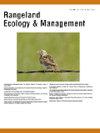利用定向放牧关闭入侵的一年生雀梅利用的物候生态位
IF 2.4
3区 环境科学与生态学
Q2 ECOLOGY
引用次数: 0
摘要
原生植物和入侵植物的物候差异可以促进入侵,但也可以成为管理的目标。在北美西部大平原地区,入侵的一年生草Bromus tectorum L.(野雀草)和B. arvensis(野雀草)比本土竞争对手更早开始和结束生长,为有针对性的放牧提供了机会。然而,管理者需要知道食草动物什么时候会优先食用或避免一年生雀稗。在美国怀俄明州和内布拉斯加州的两个混合草原区实施了为期4年的春季定向放牧,并量化了牛的时间消费模式。我们采用粪便DNA元条形码技术,每周两次测量一年生雀稗和共存的本地物种的消耗。同时,我们测量了植物物候、饲料质量和生物量。利用两种物候指标——株高和种子成熟后天数,有效地预测了年内溴雀花的消费量。目标放牧窗口定义为一年内牛最大消费量≥75%的时间段,从雀稗高9.3 cm(±3.6 SD)开始,在种子成熟后1天(±4 SD)结束,持续38 d(±11 SD)。在放牧期间,牛的日粮质量保持在较高水平。多年来,雀麦消费量占禾本科总消费量的19%至55%,并且在一年生雀麦在开花前长高的年份中一直较高。虽然牛通常选择本地多年生植物而不是一年生雀麦,但与放牧较晚的邻近牧场相比,春季定向放牧使雀麦种子产量减少了30-77%。这些结果表明,简单的物候指标可以预测牛在春季的雀稗消费量,无论是年内还是年内。仔细安排放牧时间,使其与消耗保持一致,这将有助于管理者控制一年生雀稗,恢复原生混合草草原植物群落。更广泛地说,结合牲畜饮食和植物物候的时间分析可以帮助精确定位入侵物种的放牧。本文章由计算机程序翻译,如有差异,请以英文原文为准。
Using Targeted Grazing to Close the Phenological Niche Exploited by Invasive Annual Bromes
Phenological differences between native and invasive plants can facilitate invasion, but can also be targeted by management. In the western Great Plains of North America, the invasive annual grasses Bromus tectorum L. (cheatgrass) and B. arvensis (field brome) begin and end growth earlier than native competitors, providing an opportunity for targeted grazing. However, managers need to know when grazers preferentially consume or avoid annual bromes. We implemented spring targeted grazing for 4 years and quantified temporal cattle consumption patterns at two mixedgrass prairie sites in Wyoming and Nebraska, USA. We used fecal DNA metabarcoding to measure consumption of annual bromes and coexisting native species twice per week. Concurrently, we measured plant phenology, forage quality, and biomass. Within years, brome consumption was predicted effectively using two phenological metrics—plant height and days after seed maturation. Targeted grazing windows, defined as periods with ≥75% of maximum cattle consumption within a year, started when bromes were 9.3 cm (± 3.6 SD) tall, ended one day (± 4 SD) after seed maturation, and lasted 38 d (± 11 SD). Cattle diet quality remained high throughout these grazing windows. Across years, brome consumption ranged from 19% to 55% of total graminoid consumption, and was consistently higher in years when annual bromes grew taller before flowering. Although cattle typically selected for native perennials over annual bromes, spring targeted grazing reduced brome seed production by 30–77% relative to adjacent pastures where grazing began later. These results indicate that simple phenological metrics can predict cattle consumption of bromes during spring, both within and among years. Carefully timing grazing to align with consumption should help managers to control annual bromes and restore native mixedgrass prairie plant communities. More broadly, combining temporal analyses of livestock diets and plant phenology can be useful for precisely targeting grazing of invasive species.
求助全文
通过发布文献求助,成功后即可免费获取论文全文。
去求助
来源期刊

Rangeland Ecology & Management
农林科学-环境科学
CiteScore
4.60
自引率
13.00%
发文量
87
审稿时长
12-24 weeks
期刊介绍:
Rangeland Ecology & Management publishes all topics-including ecology, management, socioeconomic and policy-pertaining to global rangelands. The journal''s mission is to inform academics, ecosystem managers and policy makers of science-based information to promote sound rangeland stewardship. Author submissions are published in five manuscript categories: original research papers, high-profile forum topics, concept syntheses, as well as research and technical notes.
Rangelands represent approximately 50% of the Earth''s land area and provision multiple ecosystem services for large human populations. This expansive and diverse land area functions as coupled human-ecological systems. Knowledge of both social and biophysical system components and their interactions represent the foundation for informed rangeland stewardship. Rangeland Ecology & Management uniquely integrates information from multiple system components to address current and pending challenges confronting global rangelands.
 求助内容:
求助内容: 应助结果提醒方式:
应助结果提醒方式:


